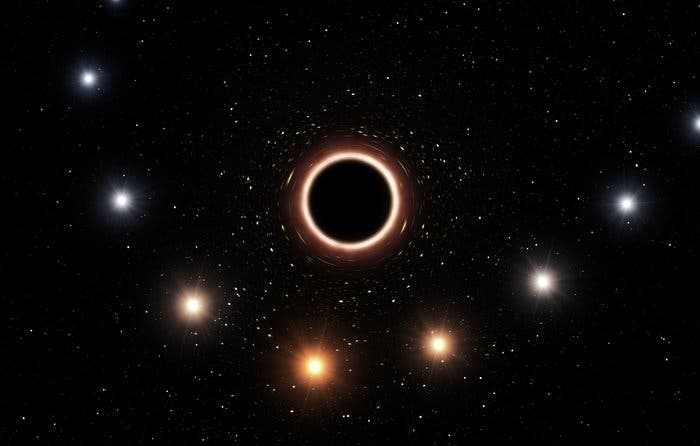
ESO/M. Kornmesser.
Like virtually all other galaxies, the Milky Way houses a supermassive black hole at its center with a mass millions of times greater than the sun. It constantly gobbles up enormous amounts of gas and dust from its surroundings but scientists have noticed that even for its gargantuan appetite, this black hole is now unusually hungry.
“We have never seen anything like this in the 24 years we have studied the supermassive black hole,” said Andrea Ghez, UCLA professor of physics and astronomy and a co-senior author of the research. “It’s usually a pretty quiet, wimpy black hole on a diet. We don’t know what is driving this big feast.”
The astronomers employed more than 13,000 observations of the black hole, called Sagittarius A*, performed by the W.M. Keck Observatory in Hawaii and the European Southern Observatory’s Very Large Telescope in Chile since 2003.
Although black holes cannot be imaged directly since their massive gravity allows nothing to escape their grasp, not even light, astronomers can see brightness at the edge of the black hole’s point of no return — the event horizon.
The brightness is generated by radiation from gas and dust that are accelerated to huge speeds as they circle the event horizon. Moving at close to the speed of light, the matter generates powerful jets of plasma containing electrons and positrons that ricochet off the event horizon and get hurled outward along the black hole’s axis of rotation. It is these enormous jets of energetic subatomic particles that emit light, which our telescopes can see. Last year, researchers were able to produce the first image of a black hole’s event horizon.
Observations of Sagittarius A* performed on May 13 showed that its brightness had enhanced considerably.
“The first image I saw that night, the black hole was so bright I initially mistook it for the star S0-2, because I had never seen Sagittarius A* that bright,” said UCLA research scientist Tuan Do, the study’s lead author. “But it quickly became clear the source had to be the black hole, which was really exciting.”
Astronomers aren’t sure what’s gone into Sagittarius A* but it’s possible that the extreme brightness swings may have been triggered after a nearby star called S0-2 made a close approach to the black hole during 2018. In the process, it should have discharged a large quantity of gas.
Another hypothesis is that G2, a binary star system was stripped off its outer layer during a close approach to the black hole in 2014. This may explain the black hole’s sudden variations in brightness just outside of it.
Alternatively, very large asteroids that ventured too close to the black hole may have contributed to the jump in brightness, the astronomers noted in a recent paper published in The Astrophysical Journal.
Whatever may be the case, the anomaly is no threat to life on Earth. The black hole is located about 26,000 light-years away from Earth and its radiation would have to be 10 billion times brighter to affect us in a significant way.
What’s perhaps more fascinating than this anomaly, however, is the way the astronomers were able to track the black hole’s feeding patterns all of these years.
In 2004, Ghez and colleagues helped pioneer a crucial piece of technology, called adaptive optics, which corrects the distorting effects of Earth’s atmosphere in real-time. This allowed them to observe more than 3,000 stars in the vicinity of Sagittarius A*.
However, astronomers have been observing Sagittarius A* since long before adaptive optics were invented. In order to make good use of observations made prior to 2004, Ghez developed a new technique called speckle holography that can use faint information from 24 years of data recorded on the black hole and fill in the blanks. The technique was recently described in The Astrophysical Journal Letters and allowed the researchers to determine that the black hole’s brightness is at an all-time high since we’ve been observing it.
Remarkably, the technique also allowed the astronomers to test Einstein’s theory of general relativity near the black hole. The researchers observed the black hole’s effects on S0-2 at it completed an orbit; effects which mirrored Einstein’s predictions.
“It was like doing LASIK surgery on our early images,” Ghez said. “We collected the data to answer one question and serendipitously unveiled other exciting scientific discoveries that we didn’t anticipate.”






